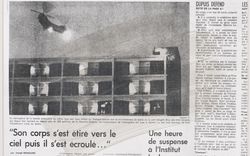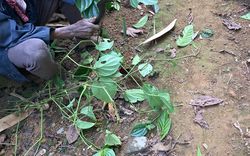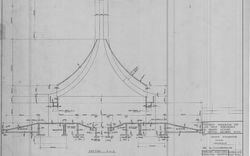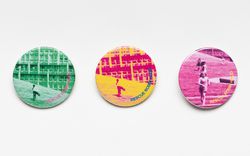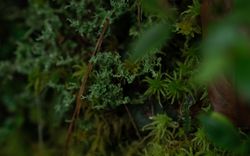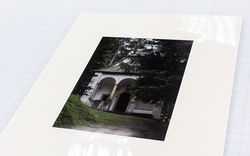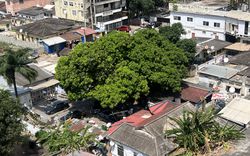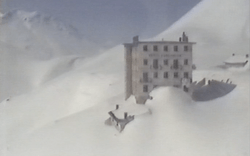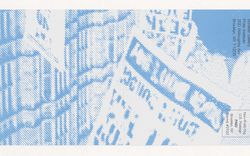Palimpsest of History
Auden Young Tura on Melvin Charney’s UN DICTIONNAIRE...
Melvin Charney was an avid collector of newspapers from when he was only thirteen years old and continuing well into the later years of his life. Charney’s grade school notebooks indicate a lifelong passion for collecting and categorizing newspaper clippings. His childhood preoccupation with geological and scientific developments would, through his architectural studies and professional endeavours, evolve into an overwhelming concern with changes to the built environment as represented through mass media. The breadth of materials in Charney’s collection—whether a newspaper clipping detailing a student protest against increased tuition, or a poster featuring a slogan from the Black Panther Party—indicate that he was broadly invested in resistance against hegemonic powers. This collection became the focus of his thirty-year project UN DICTIONNAIRE… (1970-2001), held in his fonds at the CCA.
UN DICTIONNAIRE…, which Charney described as “the primary source of much of [his] work,” is a lexicon of photographic and textual fragments gleaned from his newspaper collection.1 The project traces the language and symbolism of the built environment through a study of “upheavals,” which ultimately manifested as a series of over four hundred plates. Each plate features a silver gelatin reproduction of a wire-transfer photograph in a newspaper article, cropped to 11 x 14 inches and mounted to poster board. Finally, each plate is painted over with a partial wash of grey paint, which varies in opacity between plates, and is sorted into a category based on visual or conceptual similarities. The categories range from clearly defined ones, such as “Ruins” (Series 7), “Doors” (Series 41), or “Windows” (Series 42), to more conceptual themes like “Noah’s Ark” (Series 74) or “Cities of Hope” (Series 50).
-
Tyler Goss and Melvin Charney, “Images of Disaster: An Interview with Melvin Charney,” Log 3, no. 7 (2004): 122. ↩
When installed, the plates of UN DICTIONNAIRE… are sorted into their categories, leaving gaps between images and empty or missing categories, as well as “half” categories that may have been added after the fact. Although the project officially concluded following the events of 11 September 2001, Charney remarked that the project was never really finished, and he continued to collect newspapers with the same enthusiasm as during the height of his work on UN DICTIONNAIRE.1 These discrepancies in the organization and scope of the work confirm that UN DICTIONNAIRE was a fundamentally processual undertaking.
-
Goss and Charney, “Images of Disaster,” 121. ↩
Based on the scope of Charney’s collection, it might be assumed that these gaps are intentional—it is more than likely that an existing image would have sufficed to fill a space, or another category might have been developed from the remaining clippings. The empty spaces in UN DICTIONNAIRE… might then serve a more self-reflexive purpose, an acknowledgement that Charney’s individual perspective was limited to his local context of Montréal and the newspapers that were readily accessible to him.
Charney’s newspaper collection may have been a way for him to understand the political unrest he witnessed in Montréal during the Quiet Revolution of the 1960s and early 1970s, which resulted in an education reform, established the welfare system, and marked the start of the Separatist movement in Québec, alongside conflicts and social changes unfolding outside of Canada at the same time. In addition to his sizeable collection of newspapers, Charney also collected posters and other textual material, a number of which were kept from student protests in Québec and abroad. Charney’s tenure as a professor of architecture at the Université de Montréal placed him in close proximity to events such as the 1996 Québec student protests and informed his solidarity with the students.
UN DICTIONNAIRE… could then be thought of as a kind of cognitive map of the events experienced by Charney and mediated by their dissemination in the news. In Postmodernism, Fredric Jameson describes cognitive mapping as a “[search] to endow the individual subject with some new heightened sense of its place in the global system.”1 He asserts that a solution to our “spatial as well [as] social confusion” is a political art that embraces the paradoxical unrepresentability of “the world space of multinational capital,” which it must likewise address.2 Through UN DICTIONNAIRE…, Charney seems to accept and even embrace this unrepresentability by sampling and collecting disparate, anachronistic, and contradictory elements. Viewing his archive of unused newspapers, it becomes clear that collecting or mapping is ultimately the crux of UN DICTIONNAIRE…, which forms part of Charney’s broader struggle of tackling “spatial [and] social confusion.” Several of Charney’s other projects similarly used collecting as a means of navigating this confusion, such as his Parable series (1990) of painted photographs, or Une histoire (1975-1978), which recorded how industrialization was becoming embedded into Québecs urban landscape.
Jameson evokes Kevin Lynch’s The Image of the City (1960) as an allegory for cognitive mapping. Lynch observes that the subject in the postmodern city is untethered, unable to place oneself in the “urban totality” by way of landmarks. In UN DICTIONNAIRE…, Charney grapples with this “unrepresentable totality” by defining his own landmarks, highlighting sites where relations are fostered between people and the built environment. Images share common visual strategies such as framing, composition, or subject matter, pointing outside of their respective categories toward relationships that transcend geography, or rather ones that might exist between representations of certain placed but not necessarily among specific sites.
In one of his planning notebooks for UN DICTIONNAIRE…, Charney described the project as a “palimpsest of history.”1 In the traditional sense, a palimpsest is a layering of meaning that effaces the original manuscript. UN DICTIONNAIRE… is both literally a palimpsest, as Charney has painted over the newspaper clippings, but also metaphorically in its accumulation of varied histories of upheaval in and around the built environment. Over the thirty years that UN DICTIONNAIRE… formed an active part of Charney’s practice, he went back and made changes and additions to the structure that he had set for himself. Originally, the work did not include “obvious” events from the latter half of the twentieth century “like the Kent State shooting or the Berlin Wall,” but, following 9/11, it became important to Charney that these were incorporated.2
The categorization of the plates, which sorts images into taxonomies, evokes classification systems that aim to reinforce hierarchy and transparency. At the same time, Charney’s painting over the images actively produces opacity, a decidedly anti-hierarchical gesture. His shuffling of taxonomies and addition of interstitial categories also complicates the chronological progress of the work, making his process of sorting—or relating—these images somewhat obscure. Thus, Charney’s “[tracing of] the contours of relations,” his primary intention for the work, is convoluted and non-linear.
For Édouard Glissant, transparency is characteristic of a Western, scientific desire to make specificities and differences knowable, reifying the distinction between the self and the “Other.”1 Opacity is instead that which blurs distinctions, the “real foundation of Relation.”2 In its organization, UN DICTIONNAIRE… seems to be tethered to a Western notion of understanding through delineation. At the same time, however, Charney’s deep interest and involvement in the liberation of oppressed groups would indicate that he rejected these hierarchical modes of representation and embraced the generative potential of social and spatial confusion.
Charney’s application of paint to the plates of UN DICTIONNAIRE… is haphazard and gestural, distinct from much of his other painterly work, which was generally representational and expanded on existing forms in the underlying images. In this way, Charney’s painting in UN DICTIONNAIRE… could be considered as veiling, or withholding, the source material, intervening in the authority that newspapers and images hold in documenting relation. Glissant writes in Poetics of Relation that “to imagine the transparency of Relation is also to justify the opacity of what impels it.”3 UN DICTIONNAIRE… simultaneously attempts to imagine relation as transparent and quantifiable, nodding toward the impossibility of producing its representation in totality by rendering images—at least partially—opaque.







